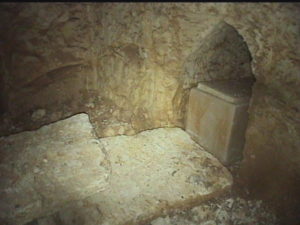
It was exposed by a dynamite blast. At the time, the blast would not have been an unexpected sound in this part of Jerusalem where, in April of 1981, the Solel Boneh Construction company was preparing to construct a new condominium complex in the East Talpiot neighborhood, less than three kilometers south of the Old City. As in many cities with an ancient past, construction workers stumbled upon something ancient and buried. In this case, it appeared to be a tomb—also not surprising, as it was located within an area long known to feature a necropolis of ancient tombs. Construction work was halted and, as is required by law, Amos Kloner, a Jerusalem district archaeologist of the Israel Antiquities Authority, was immediately called in to investigate the tomb.
He could enter the tomb only through a break in the ceiling. Its ancient square entrance was closed, sealed tight by a large “stopper” stone. What he first saw was a 3.5 by 3.5 meter rock-cut single square chamber. Cut into and along three of its sides were nine carved gabled burial niches in all (called kokhim in Hebrew), about 2 meters deep, three in each side. Each niche was sealed in front with a blocking stone. He suspected that inside the niches would be ossuaries, or bone boxes. For Kloner this would not be a surprising find, given the context. Ossuaries, or bone boxes, were commonly used by the wealthy Jewish inhabitants of Jerusalem during the 1st Century B.C.E. up until 70 C.E. to permanently store the skeletal remains of deceased family members, often in a stone-cut family tomb. Kloner observed skeletal remains in the niches, with significant primary burial remains in four of them, meaning those skeletal remains had not yet been placed permanently into ossuaries. Also found were some cooking pots placed in three locations on the floor.
_________________________________________________________________________________________
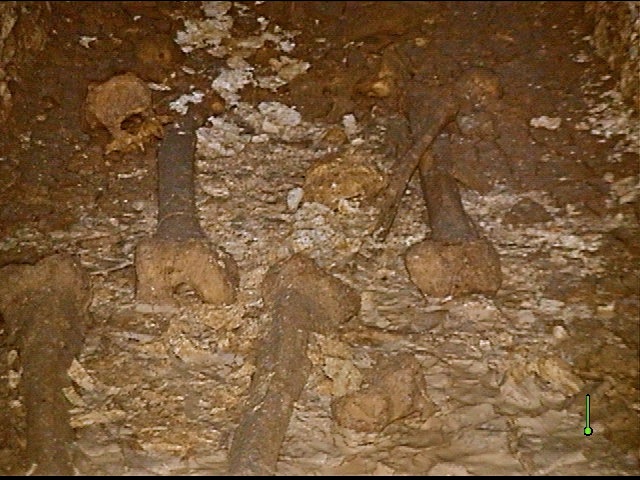 Bones found in situ within one of the niches of the tomb. Photo credit: William Tarant, GE Inspection Technologies and Associated Producers, Ltd.
Bones found in situ within one of the niches of the tomb. Photo credit: William Tarant, GE Inspection Technologies and Associated Producers, Ltd.
_____________________________________________________________________________________________________________________
But Kloner wasn’t afforded much time to examine the tomb. Soon, he was forced to leave the tomb by protesting ultra-Orthodox Jews, determined to protect the sanctity of the tomb. But this was not before he was able to acquire one smaller ossuary for examination—a decorated ossuary with no inscription, fit for the remains of a child. He entrusted it to the custody of IAA authorities at their Rockefeller headquarters (The ossuary is now part of the State of Israel collections).
Despite the protests, Kloner and the IAA were determined to investigate the find. Although he had to depart the country to fulfill another commitment, he entrusted two IAA archaeologists, the late Joseph Gath and Shlomo Gudovitch, to continue the investigation. Upon returning to the site, they were able to remove the blocking stones from the niches and examine ossuaries inside, a total of seven, taking photographs and recording their positions. All ossuaries but one were decorated and two were observed to have Greek inscriptions. They spent several days at the tomb location, removing the ossuaries from their niches and opening their lids for further examination. While preparing to raise the ossuaries up through the tomb ceiling to transport them to the IAA Rockefeller headquarters, they were again prevented from completing the task by a group of ultra-Orthodox Jewish protesters. The seven remaining ossuaries were returned to their niches, albeit not all in their original positions. There they remain to this day.
Mission (Almost) Impossible
It was not until 2005, more than 25 years later, that a new archaeological team was assembled to take another look at the tomb (today known as the “Talpiot B” or “Patio” tomb) and its contents. This latest exploration was conducted by a team co-led by prominent biblical historian James D. Tabor of the University of North Carolina, Charlotte, and noted archaeologist Rami Arav of the University of Nebraska. The team included a comparatively eclectic mix of experts, including the well-known Canadian film producer and director Simcha Jacobovici, top Canadian film producer Felix Golubev, two key technical experts, Walter Klassen and William Tarant, and Dr. James H. Charlesworth of Princeton Theological Seminary as the team’s primary academic consultant.
What prompted the new initiative was the proximity of the tomb to two other tombs, the first being the controversial, high-profile Talpiot or “Jesus Family Tomb” (also known as the “garden” tomb because of its proximity to a garden) discovered in 1980 and further investigated in 2005; and the second, a tomb mostly destroyed in 1980 by a dynamite blast during preparations for construction work. The “Jesus Family Tomb” or “garden” tomb, only 45 meters away from the subject Patio Tomb, contained nine ossuaries and a niche for a missing 10th, six of them inscribed with names: Yeshua bar Yehosef (Jesus, Son of Joseph), Maria (Mary), Yose (Joseph), Yehuda bar Yeshua (Jude, Son of Jesus), and Matya (thought to be a form for Matthew or Matthias), all in Aramaic, and Mariamenou Mara or Mariam kai Mara (Martha) in Greek. (It has been suggested by some that the controversial “James, Brother of Jesus” ossuary is the missing 10th.) The suggestion that this tomb could be connected to Jesus of Nazareth and his family opened a pandora’s box of scholarly dispute when, in 2007, it was brought into the public limelight.
“It was the proximity of these three tombs, and the possibility that they were clustered together on a wealthy estate in the 1st century CE that prompted us to request a permit to carry out further investigations,” reported Tabor in his Preliminary Report about the Patio Tomb exploration. The immediate vicinity of the three tombs also included the remains of a plastered ritual bath (or mikveh), water cisterns, and an ancient olive press. Joseph Gath, who surveyed the area, determined that they, including the tombs, belonged to a large, wealthy agricultural estate. They were likely the family tombs of the owner of the estate. “The object of our investigation was to determine whether the “patio” tomb, still intact, might contain names or other evidence that would provide for us further data that might conceivably shed light on the adjacent “garden” tomb with its intriguing cluster of names,” reported Tabor in a preliminary report of the findings. “Our stated intent in our proposal to the Israel Antiquities Authority was that we wanted to determine if further scientific information about these tombs and their possible relationship to one another might still be obtained 30 years after their initial exploration.”[1]
The team knew that re-examining the tomb would, to say the very least, be difficult. The gravity of the challenge was enhanced by several factors. First, there was the challenge of obtaining permissions from four different sources, each of which had a different agenda and a different set of interests to consider and safeguard. They included the IAA, the condominium owners (as the tomb was located below the basement of the condominium complex), the municipal police, and finally, perhaps most sensitive of all, the ultra-Orthodox Jewish groups that objected to exploration of tombs. Permission was obtained from all, provided certain conditions were met.
Even with the administrative/logistical hurdles cleared, however, there was still the technical challenge of locating, accessing, and then moving remotely within the tomb to film and record what they needed to see. Given the underground, sealed location of the tomb 25 feet below the condominium complex, the requirement not to move the ossuaries to respect the sensitivities and conditions of the ultra-Orthodox Jewish community, the dimensions and configuration of the tomb, and the extremely limited clearance space around the ossuaries within the niches, it was a monumental task that seemed almost insurmountable. It had never been done before.
_________________________________________________________________________________________
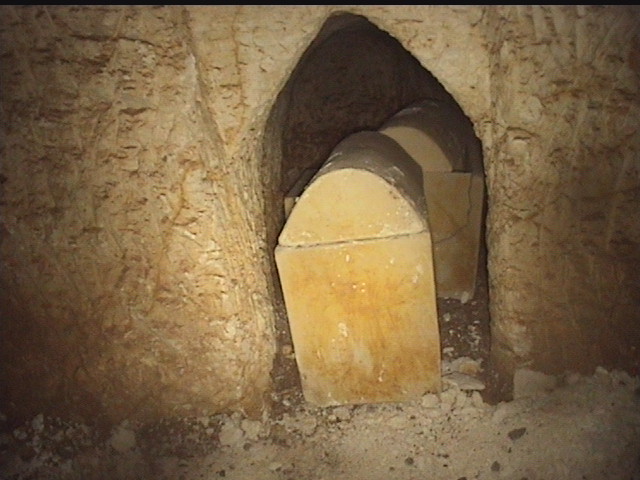
Remote camera view of one of the tomb niches containing ossuaries. The team could see that maneuvering cameras within the spaces would be a challenge, to say the least. Photo credit: William Tarant, GE Inspection Technologies and Associated Producers, Ltd.
_____________________________________________________________________________________________________________________
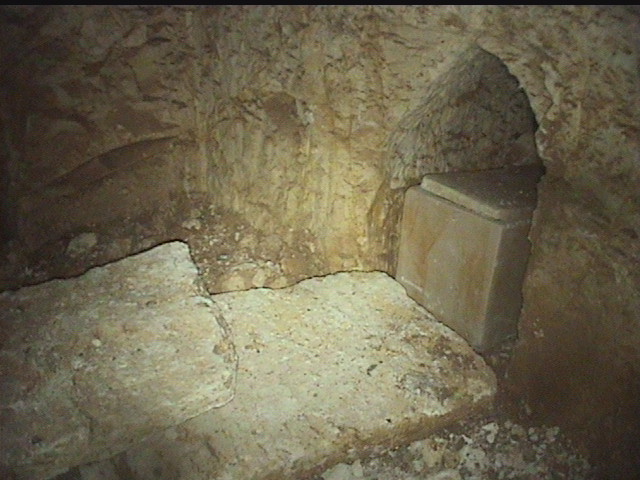
View of niche with ossuary within the tomb, showing blocking stones. Photo credit: William Tarant, GE Inspection Technologies and Associated Producers, Ltd.
______________________________________________________________________________________________________________________
Inside the Tomb
The only clue the team had regarding the precise location of the tomb was a “ritual vent” or “soul pipe”, the entry point of which was located on a patio about 25 feet above the tomb. By Jewish law, a soul pipe is required to be installed whenever construction is performed above a tomb. (The pipe allows an opening through which the soul of the deceased may escape from the tomb.) They knew that the pipe ran down directly into the tomb based on earlier preliminary investigatons, when they were able to successfully drop a small camera attached to the end of a flexible cable through the opening down into the tomb and shoot some video footage of the tomb features and contents. This aparatus, however, had no capability to maneuver about within the tomb to closely examine the contents. As one of the prime requirements was to approach close enough to the ossuaries to observe and record any markings or inscriptions that would tell them something about who was buried there and the ownership of the tomb, the team went to work to devise an innovative scheme and tool that could accomplish this. It would include a unique robotic arm and camera/video assembly specially designed for the task.*
With the specialized tools developed, the robotic arm investigation began in June of 2010. The plan was to explore the tomb systematically, working counterclockwise from the sealed entrance and going niche by niche. Not without roadblocks along the way, the team was able to obtain a more detailed view of the ossuaries, with some startling discoveries. What follows is what they discovered:
(1) Ossuary 1 was richly ornamented on its front side, including two carved rosettes, an elaborate frieze for a border, and a pillar or nephesh (a figure representing the soul) carved between the rosettes. Clear evidence of a reddish-rose paint was on the rosette petals. The rest of the ossuary was plain with no features or inscriptions, although it had deep horizontal scratches on the back.
(2) Ossuary 2 was also richly ornamented on its front side with carved rosettes and a frieze border. There was an incised marking in the upper right corner, indistinguishable upon the first examination. The rest of this ossuary was plain.
(3) Ossuary 3 featured a partial rosette with the name ‘Μapa’ faintly inscribed in Greek letters. Mapa, also written as ‘Mara’, is rarely seen on Jerusalem ossuaries of the 1st century. One of the few examples was found in the nearby Talpiot “Jesus Family Tomb” as Mariamenou Mara or Mariam kai Mara . It is often considered a version of the name ‘Martha’, found in the Gospels of the New Testament.
(4) Ossuary 4 was also ornamented, but because of its position inside its niche, including its closeness to the niche wall, the team was unable to study it closely. Its far end appeared to feature a name inscribed in Greek.
(5) Ossuary 5 showed an ornamental front façade with twin rosettes and elaborate frieze border. Interestingly, between the rosettes was a four-line Greek inscription.
(6) Ossuary 6, originally (when explored by Kloner) in the first position closest to the tomb entrance, featured perhaps the most interesting markings. Its front (museum replica pictured right) showed what the team interpreted as the image of a fish, including tail, fins, and scales, with what appeared to be a stick-like human figure with a large head emerging from its mouth. Along the top border was a series of smaller, fish-shaped images. Incised on the left end was a bell-shaped circle that featured a cross inside. On the right end was an image that appeared to be a scaled body and tail of a fish, although only the lower portion of it is shown, upended.
(7) Ossuary 7 was plain with no markings or decorations.
What Does It All Mean?
Of the finds in the tomb, the most striking and significant were the inscriptions found on ossuaries 3, 5 and 6.
As already related, ossuary 3 featured an inscription translated as ‘Mapa’ or ‘Mara’. It is considered significant for two reasons, the first being the rarity of the occurence of this name on any extant 1st century Jerusalem ossuary, and the second, the fact that the relatively rare name was found on an ossuary in a tomb only 45 meters away from the Talpiot A tomb, or famous “Jesus Family Tomb” described above, explored in 1980 and then again in detail in 2005. One might recall that the Talpiot A included, among the other names found in the tomb that were associated with Jesus in the Gospels, the name ‘Mariamenou Mara’, interpreted as another version of the name Martha.
These name interpretations and associations have been much disputed by other biblical scholars. To counter their arguments, Tabor, in making reference to the recent “Jeus Family Tomb” finds, advances these remarks in his February, 2012 Preliminary Report on the Patio tomb investigations:
Other than theological objections, the response most often offered to any probable identification of this tomb with Jesus and his family is that “the names are common.” Subsequent research has definitely shown that is not the case, either from a statistical standpoint or even a practical observation—though one hears it endless[ly] repeated even from academics who should know better. There is not a single cluster of names ever found in any tomb in Jerusalem from this period, other than this one, out of the estimated 900 that have been exposed, that one could plausibly even make the argument of correspondence with Jesus and names associated with his family. This does not prove the tomb is that of Jesus of Nazareth and his family, but it does demonstrate that its probability should not be dismissed.[1]
Ossuary 5 carried the four-line inscription in Greek. The use of Greek would not necessarily be considered extraordinary. The translated text, however, reading as it were like an epitaph, was quite extraordinary under these circumstances. More unusual still was the use of the word for the name of God, Yahweh, written in Greek on a 1st century ossuary in what is clearly a tomb belonging to a Jewish family of the time, and words that expressed a raising up or resurrection (“rise up to God”, or “rise up to heaven”). As Tabor describes it in his Preliminary Report:
We are convinced that our inscription clearly makes some affirmation about either resurrection from the dead or lifting up to heaven…….Although it is true that ideas of resurrection of the dead and even ascent to heaven are found in a multiplicity of Jewish sources in the late 2nd Temple period, they do not appear as expressions in burial contexts unless we have an exception here in the Talpiot tomb. That, along with the unprecedented example of writing the divine name Yahweh in Greek letters in a Jewish tomb—a place of tum’a or ritual defilement—argues for a heterodox or sectarian context. The family buried in this tomb are Jews to be sure, and the style of the tomb, the ornamentations of the ossuaries, and everything else about it is nothing out of the ordinary— other than these semi-informal inscriptions of both epitaph and icon.[1]
Considering these finds alone, the Talpiot B or Patio tomb, like the Talpiot A or “Jesus Family Tomb”, stood out from all others of its kind, and there are about 900 discovered thus far.
As though the other finds were not rare enough, Ossuary 6 with its fish inscriptions, perhaps the most sensational and most controversial discovery emerging from the tomb, was rarer still. This was, according to the investigative team interpretation, not only because they could be images of a fish, an animal, on a 1st century Jewish ossuary (something that would have been prohibited by 1st century Judaism), but because the imagery was similar to that seen within the 3rd and 4th century CE Christian tombs of the catacombs in Rome—the “sign of Jonah” (as in Jonah and the whale of the biblical account) images that symbolized the resurrection. As Tabor proposed in the Report:
We interpret this drawing as a presentation of the biblical story of Jonah and the “big fish.” In ancient Jewish art there are no attested representations of Jonah and the fish. Other biblical scenes are common such as Abraham’s sacrifice of Isaac, Noah and the ark, Moses and the burning bush, Daniel in the lion’s den, especially in the 3rd and 4th centuries CE. In contrast, images of what is called the “Jonah cycle” occur over 100 times in early Christian art, most often in tombs, as a way of proclaiming and celebrating the resurrection of Jesus—and thus Christian resurrection hope more generally. [1]
______________________________________________________________________________________________________________________
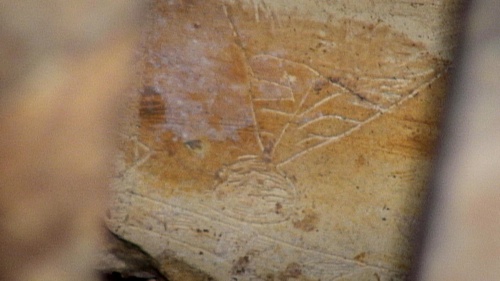 Focused view of the head/mouth of the fish image on ossuary 6. Photo credit: William Tarant, GE Inspection Technologies and Associated Producers, Ltd.
Focused view of the head/mouth of the fish image on ossuary 6. Photo credit: William Tarant, GE Inspection Technologies and Associated Producers, Ltd.
_____________________________________________________________________________________________________________________
Could the ‘Jonah’ or fish image actually be something else?
Other scholars have suggested so, and it has been one of the most hotly contested issues of the tomb discoveries. The most prominent interpretation advanced by others is that the fish-like images, particularly the largest image, actually represent amphorae or funerary nepheshes or pillars, images that are not uncommonly inscribed on ossuaries. To this Tabor has responded that his research team has “carefully examined all the extant examples of nephesh and amphora on ossuaries of this period and have not found anything that is even close” in appearance, despite the fact that the image was comparatively crudely drawn. “It was clearly done by a family member, or someone associated with the family, who was not a professional engraver. It is nonetheless the most elaborately carved ossuary in the tomb, testifying to the importance of its individual and particular expression.”[1]
To this has recently been added the work of James H. Charlesworth of Princeton Theological Seminary, who announced the deciphering of a four letter inscription on the ossuary that spells out the name “Jonah” (the same as ‘Yonah’) in ancient Hebrew. Charlesworth is the George L. Collord Professor of New Testament Language and Literature and director of the Dead Sea Scrolls Project at Princeton. He is a noted expert in the epigraphy of the Dead Sea Scrolls and the Herodian script of the period to which the tomb is dated. Another well-known epigrapher, Robert Deutsch, has confirmed Charlesworth’s reading of YONAH, although his noted epigrapher colleague Haggai Misgav of Hebrew University reads the markings as ZOLAH rather than YONAH. Other epigraphers have been invited to examine and analyze the inscription for additional perspectives.
________________________________________________________________________________________
 Closeup view of ossuary 6 with YONAH inscription highlighted. Background photo credit: William Tarant, GE Inspection Technologies and Associated Producers, Ltd.
Closeup view of ossuary 6 with YONAH inscription highlighted. Background photo credit: William Tarant, GE Inspection Technologies and Associated Producers, Ltd.
_________________________________________________________________________________________________________________________
Thus, put together, the most significant finds and their interpretation from the original investigative team’s perspective is summed up well in the words of Tabor:
“………..We are dealing here with a family or clan that is bold enough to write out the holy name of God in a tomb, with a declaration about “raising up” or resurrection—something totally unparalleled in any of the 900 tombs from the period known in Jerusalem. And further, this is a family that is willing to put an image of a fish and a human, both eschewed by pious Jews as “graven images” on the most prominent ossuary in this wealthy tomb— located at the front of the first niche on the right as one enters the tomb—and fill it with the bones of more than one family member…………..We are convinced that the best explanation for these unusual epigraphic features in the Talpiot “patio” tomb is its proximity to the Jesus family tomb less than 45 meters away. What we apparently have is a family connected to the Jesus movement who reaches beyond the standard burial norms of the Jewish culture of the period to express itself individually in these unique ways.” [1]
Other scholars have strongly disputed this interpretation. But it has raised some intriguing popular questions: Is the Patio tomb, together with the nearby “Jesus Family Tomb” and 3rd tomb (mostly destroyed during construction work), a cluster of tombs belonging to a wealthy family, perhaps even that of Joseph of Arimathea, the wealthy member of the Sanhedran who, according to the Gospels, donated a tomb for the burial of Jesus after Jesus‘ Crucifixion? Or, aside from the hypothetical association with Joseph of Arimathea or a wealthy Jewish family, was it associated with the early followers of Jesus, those that made up the initial “inner circle”, including family members? Or was it both?
“Whether one might identify it as “Christian,” or, to be more historically precise, as associated with the early followers of Jesus, is another question,” writes Tabor. “I would strongly argue in the affirmative.”[1]
_______________________________________________
* The detailed account of how the technical team gained access and remotely moved about the tomb is presented in the article, Probing the Secrets of Jerusalem’s Patio Tomb, by team member William Tarant.
[1] A Preliminary Report of a Robotic Camera Exploration of a Sealed 1st Century Tomb in East Talpiot, Jerusalem. James D. Tabor, University of North Carolina at Charlotte
Some of the views expressed in this article are the views of the exploration team and do not necessarily represent the views of the Editor and staff of Popular Archaeology Magazine.
_______________________________________________
Read about the most fascinating discoveries with a premium subscription to Popular Archaeology Magazine. Find out what Popular Archaeology Magazine is all about.





